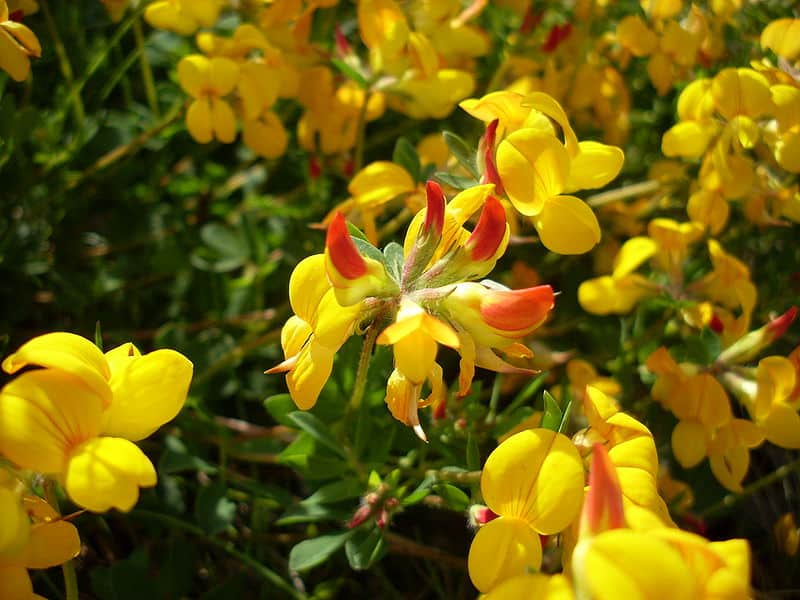Lotus Corniculatus Facts
- The term of Lotus Corniculatus serves as the scientific name of a stunning and extremely unusual, small flowering plant. It also goes by several common names, though. These include such unusual titles as the birdsfoot deervetch, and even the comical eggs and bacon.
- But, regardless of the name one uses for it, the gorgeous plant remains a true marvel of Nature and evolution. This actually holds true for reasons other than just its beauty, however. Believe it or not, the stunning species actually constitutes a member of the pea family.
- You do not want to eat it, though, regardless of its remarkable visual appeal. That’s due to one very astonishing fact. That’s the truly startling knowledge that this botanical beauty actually contains naturally occurring trace amounts of the deadly chemical cyanide.
- In extremely small amounts, however, this beautiful and remarkable species actually has some specific medicinal uses. To the great surprise of many people, though, the beautiful plant also actually gets widely used as a source of forage for many types of livestock.
- Fortunately for them, the majority of animal varieties kept as livestock have a specific advantage over human beings. That’s true since many of these creatures have the ability eat the beautiful, yet quite dangerous, Lotus Corniculatus without incurring harmful effects.
- As a rule, most animals have a much greater natural tolerance for small concentrations of cyanide than homo sapiens. Fortunately, the flora also has a comparatively wide range of natural distribution. The IUCN therefore currently has no listing for it on the Red List.
Related Articles
Lotus Corniculatus Physical Description
Astonishingly, though seemingly extremely delicate, the magnificent Lotus Corniculatus surprises most individuals for multiple reasons. That’s due to the fact that this particular variety of Angiosperm conceals a great many marvels. Among those is the fact that it’s actually quite hardy.
Nonetheless, sheer physical size does not rank as one of the astounding characteristics of the beautiful Angiosperm. That remains true since this beautiful herbaceous plant only achieves a maximum known height of approximately 8 in (20 cm) unless supported by other plants.
This truly stunning flora also most commonly grows in a highly sprawling manner along the ground. Yet, it very rarely does so over great distances, however. The small flowers of the gorgeous product of Nature additionally display multiple combinations of orange and yellow color.
These stunning blooms also appear in clusters, typically ranging from 2-7 in number. Each flower has the typical legume structure with a banner, wings, and keel. Each of its stunning blooms remains separately small, though. These structures average 0.4 – 0.8 in (1 – 2 cm) in length.
The leaves of the Lotus Corniculatus also merit a certain degree of interest. These develop as compound, with three main leaflets, and two more the base. In shape, they appear oblong to elliptical, usually with a blunt tip. These develop as green, sometimes with a slight blueish tint.
The leaves of the remarkable plant also most commonly grow in groups of five. Typically, three of these form a natural trefoil pattern over the other two. Not surprisingly, since it constitutes a member of the pea family, the seeds of this wonder develop in small, highly elongated pods.
- Kingdom: Plantae
- Phylum: Angiosperms
- Class: Eudicots
- Order: Fabales
- Family: Fabaceae
- Genus: Lotus
- Species: L. corniculatus
Lotus Corniculatus Distribution, Habitat, and Ecology
Surprisingly, the visually breathtaking and scientifically fascinating Lotus Corniculatus evolved as endemic to a remarkably large section of the globe. In point of fact, the intriguing plant inhabits an impressively wide swathe of the continents of Europe, Asia, and Northern Africa.
Due to its comparative hardiness, farmers often actually use this botanical beauty in cultivation, especially in certain parts of Europe. As a result of this surprising practice, this wonder of Nature has become considered an invasive species in some portions of Australia and North America.
Despite its seeming fragility, the visually captivating wonder of evolution displays an impressive degree of flexibility regarding its choice of habitat. It’s therefore found in a surprisingly broad range of ecosystems within its native range. This provides it with an evolutionary advantage.
It mainly appears in grasslands and meadows. These regions include both natural and semi-natural areas, sometimes including pastures. It also prefers well-drained soils and areas with moderate fertility. Yet, it’s also seen along roadsides, railway embankments, and other disturbed sites.
The remarkably intrepid plant’s additionally frequently spotted at the edges of woodlands, and in clearings within many forests. It generally prefers bright sun, but tolerates shade. Though less common, heathlands and moorlands also serve as another area it sometimes inhabits.
The Lotus Corniculatus achieves its pollination via the actions of a variety of locally prevalent pollinators, including bees, butterflies, and other insects. These creatures also remain crucial for the reproductive success of many plants and contribute to the biodiversity of the ecosystem.
It serves vital purposes where it appears. It provides both habitat and food for many insect species, supporting complex food webs. Its seeds and foliage also serve as food for birds and small mammals. Numerous grazing animals, such as rabbits and deer, also feed on the plant.
Species Sharing Its Range
Check out our other articles on 7 Amazing Australian Species, Bald Eagle, Eternal Flame Falls, Vietnamese Centipede, Red Crested Tree Rat, Sarcastic Fringehead, Happy Alien, Hermann’s Tortoise

